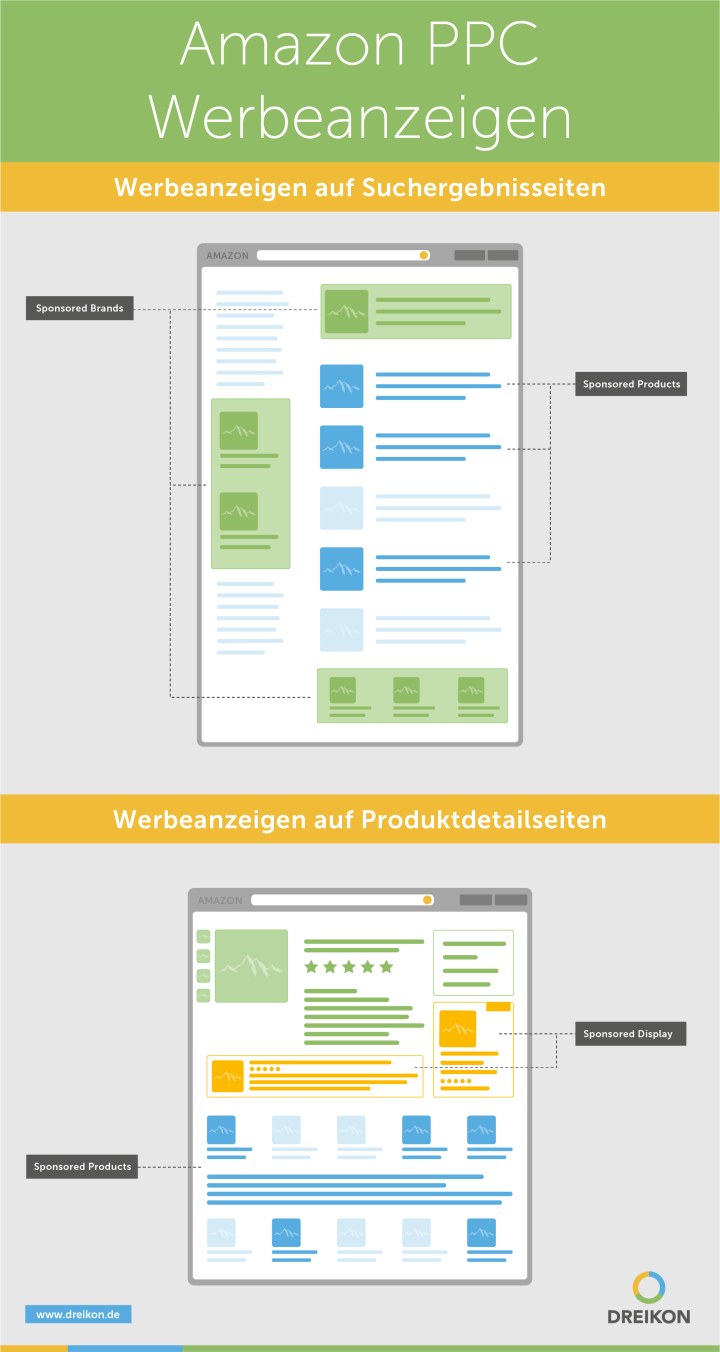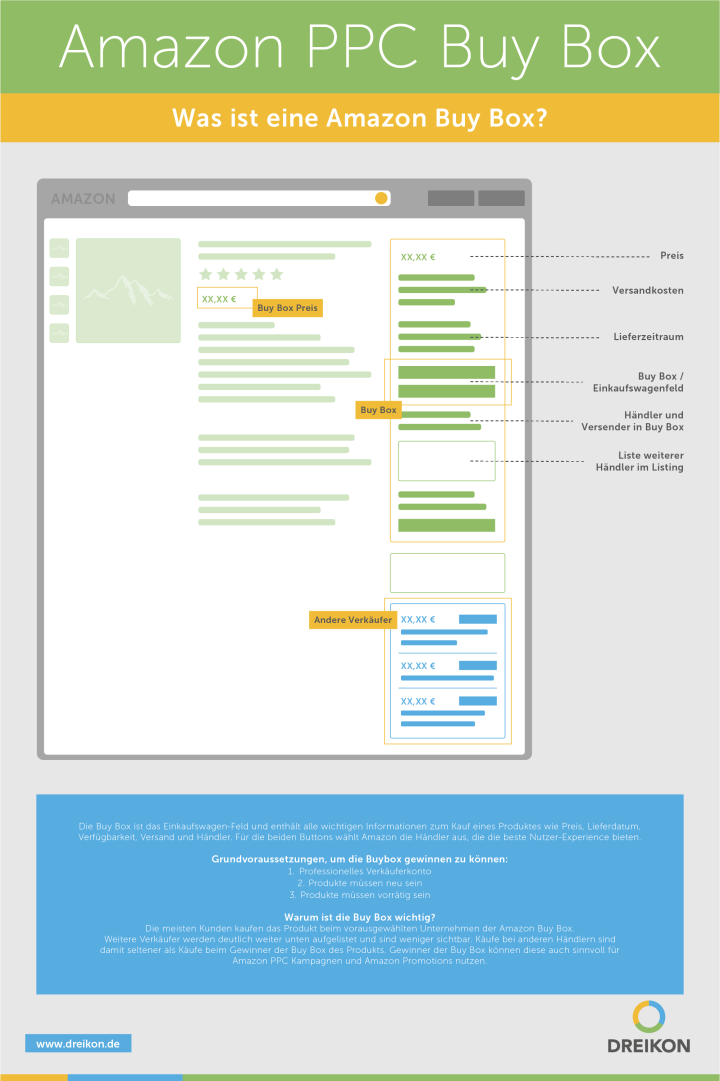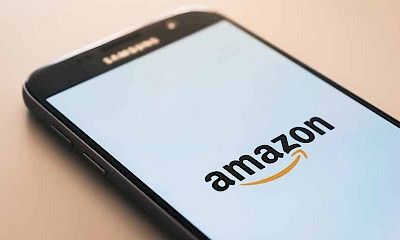
What is Amazon PPC?
More insight for beginners
What is Amazon PPC actually? If you want to market your products on one of the largest e-commerce sales platforms, Amazon PPC is a topic you can't avoid. Amazon dominates German online retail and its strong influence often determines which products are successful and which are not. If you are reading this article, you have probably already set up a company page. In order to inspire buyers for your products and to reach those who are interested in your products, it is a good idea to manage Amazon PPC (pay-per-click) and place paid advertisements. Find out here what Amazon PPC actually is, the most important basics and why Amazon Ads could be worthwhile for you.

What is Amazon PPC?
Amazon offers sellers various ad models with PPC to place advertisements. PPC stands for pay-per-click and means that advertisers only have to pay for an ad if it is actually clicked on by interested parties. Amazon PPC offers advertisers the opportunity to place products in predefined positions on a search results page and increase the visibility of their own products. As the products are thus shown more often to searchers with the intention to buy, sales figures can be increased considerably. The abbreviation PPC can be used synonymously with the cost-per-click used by Google.
Now that you know what Amazon PPC is, you should also know which formats you can place the ads for. Three advertising formats or ad types are possible:
Amazon Sponsored Products: Advertisements for individual products within the search results, similar to Google Ads. The ads are keyword or ASIN (Amazon Standard Identification Number) related. This format is the most popular.
Sponsored Brands: Banner ad for more brand awareness. Usually appears above the search results with the aim of directing users to the Amazon Store page or an individual page (e.g. a product detail page). With this format, you can choose between a banner (headline, logo and up to three products) or a video ad.
Sponsored Display ads: Sponsored Display ads are delivered on Amazon itself as well as on Twitch and third-party websites and apps on selected marketplaces and redirect customers to Amazon product detail pages. Additionally, ads can be targeted to similar products or categories, and remarketing allows you to target customers who have viewed your or similar product detail pages in the past. Display ads can be a useful addition to the remarketing of your products.


Why is Amazon PPC important?
To sell products better and faster on the online platform, vendors and sellers have the option of using Amazon PPC. This greatly increases the visibility of products, as the advertised products appear more frequently and in higher positions on the search results pages than the organic rankings. This can boost the sales figures of any product. It is also important to place ads on the platform to push new products right at the start - as these are not bought very often at the beginning due to a poor ranking position and low visibility. With PPC, you can be displayed on the first search results page and thus help your product to gain more visibility, a better ranking position and ultimately more sales. If you have already achieved a top position in the organic rankings, Amazon PPC can help you to defend this position or increase your success even further. You can also advertise targeted campaigns for sales, special offers or seasonal products to attract more attention.
Does Amazon PPC support the organic ranking?
Unlike Google Ads, Amazon PPC influences the organic ranking of a product. More sales of a product through Amazon PPC leads to a positive influence on the organic ranking - this means that your product can be displayed more frequently and in a higher position. This effect is particularly important for new products: without advertising, it is difficult to be found by potential buyers at all, as products do not have a good ranking due to a lack of or insufficient sales history. With paid ads, however, you can direct important traffic to new products and thus generate sales. This will also have an impact on the organic ranking, which can improve over time.
Who is Amazon PPC useful for?
Amazon PPC can be used by anyone who sells products on the platform to increase sales. However, a distinction is made between sellers and vendors - as different advertising platforms are made available to them.
What are vendors?
Vendors do not sell their goods themselves, but have their products bought by the online giant itself - Amazon then sells them itself on the marketplace under its own name. Vendors therefore have no direct business relationship with the customer, as sales and shipping are handled by Amazon. However, vendors have the option of placing the following ad formats with Amazon Advertising: Sponsored Products, Sponsored Brands, Stores, Product Display Ads, Video Ads and Amazon DSP.
What are Sellers?
Sellers sell their goods directly to the target group and can ship their goods themselves or through Amazon. Sellers use Seller Central to place advertisements. Amazon Sponsored Product Ads and Amazon Sponsored Brands Ads (only available to brand owners) are available to you as advertising options.
How does Amazon PPC work?
With Amazon PPC, the allocation of ad spaces is regulated via an auction system based on keywords and products. To appear with your ad in the search results, you as a seller or vendor must bid a certain amount for each keyword. The amount should be chosen so that it covers the maximum amount you are willing to pay. In addition to the bid for keywords or products, other factors are also included in the ranking, such as merchant performance. This is comparable to the quality factor on Google. As with Google Ads, the allocation of the ranking corresponds to a second price auction. This means that the highest bidder only pays the bid of the runner-up.

What should you do before you start with PPC?
Optimize product detail page
Before you start with Amazon PPC, it is necessary to optimize your product detail page in order to achieve the highest possible conversion rate - because if a potential buyer clicks on your ad, then lands on a poorly optimized listing and ultimately leaves the product detail page again, the bounce rate increases and, as a result, your advertising costs skyrocket. You can increase the conversion rate with informative product photos, product texts that clearly point out the advantages of your product and attractively expanded brand content. Also make sure you have reviews. A large number of good reviews are important for customers to click on your product in the first place and consider it for a purchase.
Define your advertising budget
To be able to place product ads efficiently with PPC, you should determine the available budget. With the help of predefined advertising expenditure, you can decide which bidding strategies to use for the individual campaigns. When selecting the strategy, the profit margin should always be taken into account so that the placements achieve the desired sales. Depending on the type of advertising, you can choose between a daily and a term budget.
Win BuyBox
Before you can advertise your product with Amazon PPC, you must first win the BuyBox for your product - assuming there are already several sellers selling your product. The BuyBox is awarded to the vendor who can demonstrate the best user experience. This includes price, customer satisfaction, sales history and the availability of Prime. If the BuyBox is owned by a competitor, you will only increase your competitor's sales figures with your advertisements. The ad rank is not the same as the BuyBox.


The right keywords are fundamental for a successful advertising campaign
With keywords, you define the search queries for which your ads should be delivered. This form of targeting is very dynamic, as in addition to the campaign settings you have defined, the search volume of the advertised keywords also determines the frequency of ad delivery. Please note that non-specific keywords for which search queries can be made in several contexts are less profitable.
Which keyword types can be used?If you use Amazon PPC, you should also consider the relevant keywords for your own offer. As bids are always placed for individual keywords, these should be as relevant as possible for the customer. This is because the products displayed should match the search query as precisely as possible in terms of the customer experience.Example: You are a purse provider. If you place ads for "handbags", you will not be displayed as often as for the term "purse" or the synonyms "wallet" or "purse". Choosing the right keywords is therefore crucial for setting your ads up for success.
The keyword types
It is advisable to have a keyword list of around 200 to 1,000 relevant keywords. However, these should be divided into these three keyword types:
Fatheads (Exact match type)
The advertisement is displayed for the exact search terms of the user. Minor spelling differences (upper and lower case, singular/plural, umlauts, etc.) are corrected automatically. You should focus on 5 to 10 fatheads for your product (e.g. wallet).
Tails (match type phrase)
Descriptive keywords for the product (e.g. black TV)
Tails describe further properties of the product and consist of at least two keywords. In short phrases, you can narrow down the focus of the ad (e.g. ladies purse). Your phrase then also applies to search terms such as "black ladies purse" or "large ladies purse".Longtails (match type broad)
The more detailed you describe your product, the more accurately your ads will be displayed. Detailed descriptions such as "large wallet ladies 10 compartments zipper" are more specific and can express a very clear customer need.
Keywords can be played out exactly, as a phrase or via the match type "broad". A broad match means that the ad is displayed for all search queries in which the search term contains the keyword in any order.

These are the targeting options
Three different targeting options are available when setting up the campaign:
Keyword targeting: advertising on your own keywords
Product targeting: advertising with the competition
Category targeting: advertising in categories
The available options also depend on the type of ad selected, so not all three options are always available.
Anyone using Amazon PPC should also be aware of negative targeting options in order to specifically exclude terms and thus avoid unnecessary campaign costs. The ads do not appear when users specifically search for these excluded terms. This will help you avoid irrelevant clicks on your product detail page. Choosing the right search terms is therefore crucial to the success of your ads.
Which keyword tools are useful? The following tools will help you to identify the best keywords
Setting up the campaign structure
When setting up the advertising measures, you should first look at your sales history and the product sets currently available. Which products should be advertised? How high is the daily budget that you want to spend on your ad placement? How can these products be grouped into campaign types? In addition to increasing product sales, do you also want to increase awareness of your brand? Which target group is most relevant? The information you gather will help you to efficiently structure the ad groups for the product focus of your strategy.
Tracking success
As with all online marketing measures, it is also important to keep an eye on the figures for Amazon PPC. The following data can help you to better assess the performance of your campaigns:
Advertising Cost of Sales (ACoS): The ACoS puts advertising expenditure in relation to the advertising revenue generated.
Calculation: ACoS = advertising expenditure / advertising revenue x 100Click-through rate (CTR): The CTR (also click-through rate) indicates how attractive an ad is for the customer.
Calculation: CTR = number of clicks / number of impressions x 100Conversion rate (CVR): The CVR indicates how convincing the product detail pages are (shortly before the purchase is completed) and, as a percentage, how many of the clicks converted to purchases. A good CVR is a possible indication of a good product or a good optimization.
Calculation: CVR = number of purchases / number of clicks x 100- Cost per click (CPC): Shows the click price for an ad and can provide information about the intensity of competition in a category.
Calculation: CPC = is regulated via an auction system of the platform (second-price auction) - Return of Ad Spend (ROAS): The reverse calculation of the Advertising Cost of Sales. Provides information on how profitable an ad is and how the advertising expenditure of the paid ads relates to the sales that were generated.
Calculation: ROAS = advertising revenue / advertising expenditure
The KPIs mentioned can vary greatly depending on the category and format. They should be monitored individually and over a longer period of time in order to be able to assess them correctly. It can be helpful to compare the figures with values from reference groups in order to better evaluate the values and identify necessary optimizations (e.g. bid adjustments) more quickly.
Conclusion - Amazon PPC is worthwhile
Now you not only know what Amazon PPC is, but also that it is one of the most important tools to survive on the platform. Whether you're a vendor or a seller, ad placement on the platform should always play a role. With PPC ads, you can push new products, defend your existing ranking or improve your organic ranking. In addition to selecting the most relevant keywords, it is important to optimize your product detail page first to minimize the bounce rate and thus increase your sales figures.

Get a taste for Amazon PPC?
Would you like to try Amazon PPC? As an Amazon SEO agency, we advise our customers on all aspects of Amazon and present your brand and products there profitably. We are available for a personal and non-binding initial consultation!
What is Amazon PPC?
What Amazon PPC is, how it works and how you can use it profitably has been sufficiently described in this article. A superficial understanding of how it works will not enable you to be successful with this tool in the first step. This requires experience, which we have as an Amazon PPC agency. Nevertheless, with the answer to the question "What is Amazon PPC?" you now have the opportunity to better evaluate this topic for yourself.










